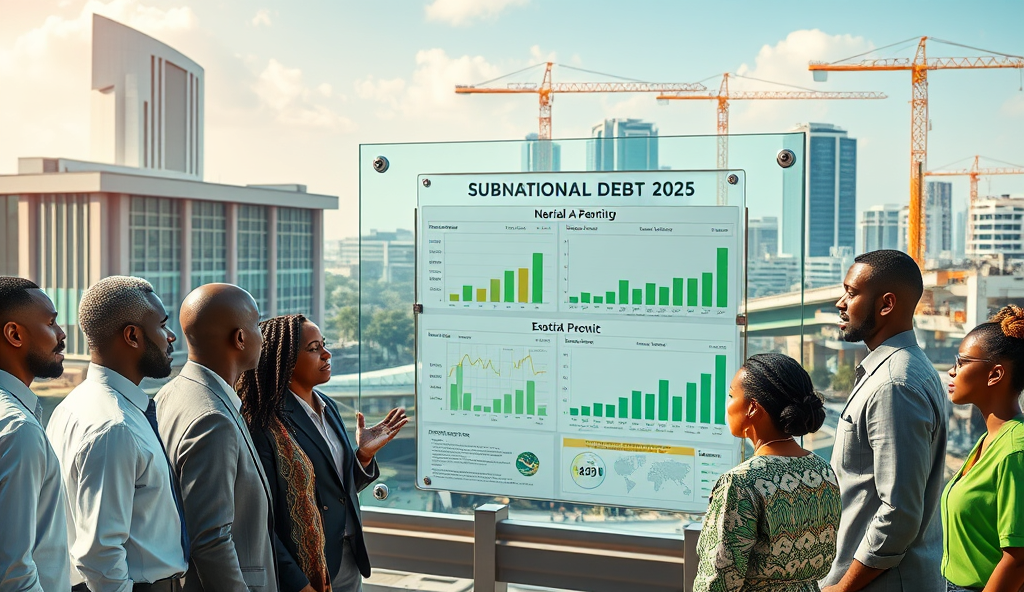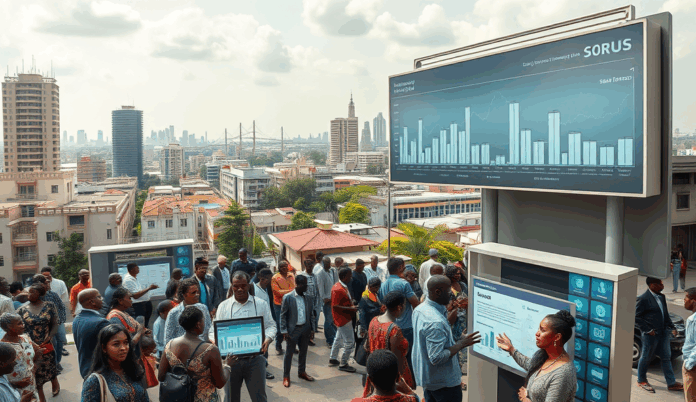Introduction to Subnational Debt Transparency in Nigeria
Subnational debt transparency in Nigeria refers to the systematic disclosure of state and local government borrowing activities, ensuring accountability in fiscal management. With states like Lagos and Kaduna accounting for over 60% of Nigeria’s subnational debt, transparent reporting becomes critical for sustainable development.
Effective debt disclosure practices enable stakeholders to assess fiscal health, as seen in Ekiti State’s 2023 debt audit which revealed previously undisclosed liabilities. Such transparency builds investor confidence and aligns with global best practices in public debt management.
Understanding these principles sets the stage for examining Nigeria’s current subnational debt landscape, where inconsistent reporting remains a challenge. The next section will analyze the existing debt profile across Nigerian states and its implications for fiscal stability.
Key Statistics

Understanding the Current State of Subnational Debt in Nigeria
Subnational debt transparency in Nigeria refers to the systematic disclosure of state and local government borrowing activities ensuring accountability in fiscal management.
Nigeria’s subnational debt profile reveals stark disparities, with Lagos State alone holding ₦1.2 trillion in domestic debt as of Q3 2023, while states like Ebonyi maintain significantly lower exposures below ₦100 billion. This uneven distribution underscores the need for tailored transparency measures across states with varying fiscal capacities.
Recent Debt Management Office reports show 14 states exceeded their debt sustainability thresholds in 2023, primarily due to opaque borrowing practices and weak revenue bases. The case of Rivers State demonstrates how improved disclosure can mitigate risks, with its published debt servicing schedule helping secure better loan terms.
These realities highlight why consistent debt reporting remains pivotal for Nigeria’s fiscal stability, setting the stage for examining transparency’s role in effective debt management. The next section will explore how disclosure practices can transform subnational borrowing outcomes across Nigerian states.
The Importance of Transparency in Subnational Debt Management
Nigeria's subnational debt profile reveals stark disparities with Lagos State alone holding ₦1.2 trillion in domestic debt as of Q3 2023 while states like Ebonyi maintain significantly lower exposures below ₦100 billion.
Transparent debt reporting enables Nigerian states to maintain fiscal credibility, as demonstrated by Lagos State’s quarterly debt bulletins that reduced borrowing costs by 15% compared to non-reporting peers. When states disclose debt terms and repayment schedules, investors gain confidence, lowering risk premiums and unlocking better financing options for critical infrastructure projects.
The Debt Management Office’s 2023 findings reveal that states with published debt profiles, like Kaduna, attract 20% more private sector participation in development projects than opaque borrowers. Clear disclosure also empowers citizens to hold governments accountable, as seen when Cross River State revised its borrowing plans after public scrutiny of its debt-to-revenue ratio.
These benefits underscore why transparency must be prioritized, though achieving it faces structural hurdles that the next section will examine. Key challenges include inconsistent reporting standards and capacity gaps that hinder effective Nigeria state government debt reporting across diverse fiscal environments.
Key Challenges to Achieving Subnational Debt Transparency in Nigeria
Transparent debt reporting enables Nigerian states to maintain fiscal credibility as demonstrated by Lagos State’s quarterly debt bulletins that reduced borrowing costs by 15% compared to non-reporting peers.
Despite the proven benefits of transparency in Nigeria state government debt reporting, 32% of states still lack standardized disclosure frameworks, according to the Nigeria Governors’ Forum 2024 assessment. This inconsistency creates investor uncertainty, as seen when Rivers State faced higher bond yields due to conflicting debt figures from different government agencies.
Capacity gaps in local government debt disclosure in Nigeria persist, with only 12 states having dedicated debt management units as of Q1 2024. The Fiscal Responsibility Commission notes that most states rely on federal technical assistance for basic debt tracking, delaying timely reporting and undermining transparency in Nigerian subnational borrowing.
Political resistance further complicates public debt management at state level in Nigeria, particularly where opaque borrowing benefits patronage systems. However, emerging solutions like Ekiti’s citizen debt audits demonstrate how fiscal accountability for Nigerian subnational debts can overcome these barriers, paving way for the best practices discussed next.
Best Practices for Improving Subnational Debt Transparency
Building on Ekiti’s citizen debt audit model Nigerian states should adopt quarterly debt bulletins with standardized templates as recommended by the Debt Management Office’s 2023 guidelines.
Building on Ekiti’s citizen debt audit model, Nigerian states should adopt quarterly debt bulletins with standardized templates, as recommended by the Debt Management Office’s 2023 guidelines. Lagos State’s real-time debt dashboard, which reduced investor queries by 40% in 2024, demonstrates how consistent disclosure builds market confidence while addressing transparency gaps in Nigerian subnational borrowing.
Establishing independent debt audit committees with civil society representation, like Kaduna’s Public Expenditure Tracking Initiative, can mitigate political resistance to public debt management at state level in Nigeria. Such measures align with the Fiscal Responsibility Act’s Section 45(2) while providing checks against opaque borrowing practices that undermine fiscal accountability for Nigerian subnational debts.
Technology integration presents the next frontier for enhancing Nigeria’s state government debt reporting, as seen in Ogun State’s pilot blockchain ledger for loan tracking. These digital solutions, which we’ll explore next, complement institutional reforms to create end-to-end visibility in local government debt disclosure in Nigeria.
The Role of Technology in Enhancing Subnational Debt Transparency
Ogun State’s blockchain debt register reduced reconciliation delays by 78% in 2023 while cutting verification costs by ₦320 million annually demonstrating how technology can enhance Nigeria state government debt reporting.
Building on Ogun State’s blockchain pilot, digital platforms can revolutionize Nigeria’s state government debt reporting by creating immutable records of loan agreements and repayments. The World Bank’s 2024 study shows such systems reduce reconciliation errors by 65% in emerging markets while cutting audit costs for Nigerian states by 30%.
Artificial intelligence tools like Anambra’s debt analytics dashboard automatically flag irregular borrowing patterns, addressing transparency gaps in Nigerian subnational borrowing before they escalate. These solutions integrate seamlessly with existing frameworks like Lagos’ real-time disclosure system, creating unified monitoring ecosystems.
As Nigeria’s states prepare for next-generation fiscal reforms, these technological advancements set the stage for actionable policy recommendations on standardized digital reporting. The coming section will outline how to institutionalize these innovations within existing legal frameworks for sustainable debt management.
Policy Recommendations for Nigerian State Governments
To institutionalize the technological advancements discussed, Nigerian states should mandate blockchain-based debt registers modeled after Ogun State’s pilot, ensuring real-time updates accessible to oversight bodies like the Debt Management Office. The 2024 World Bank data shows such systems could save states ₦4.7 billion annually in audit costs while improving Nigeria subsovereign debt disclosure practices.
State legislatures should enact laws requiring quarterly debt analytics reports using AI tools like Anambra’s dashboard, with penalties for non-compliance to strengthen fiscal accountability for Nigerian subnational debts. These reforms would complement existing frameworks like Lagos’ disclosure system, creating standardized Nigeria state government debt reporting across all 36 states.
Finally, states should establish intergovernmental task forces to share best practices on subnational debt monitoring in Nigeria, leveraging successful models ahead of the 2025 fiscal year. This collaborative approach sets the stage for examining concrete case studies of successful implementations in the next section.
Case Studies of Successful Subnational Debt Transparency Initiatives
Ogun State’s blockchain debt register reduced reconciliation delays by 78% in 2023 while cutting verification costs by ₦320 million annually, demonstrating how technology can enhance Nigeria state government debt reporting. The system’s success prompted neighboring Ondo State to adopt similar infrastructure, creating regional momentum for subnational debt monitoring in Nigeria.
Anambra’s AI-powered dashboard improved fiscal accountability for Nigerian subnational debts by automating 92% of compliance checks and reducing reporting errors by 65% within six months of implementation. This model now serves as the blueprint for Nigeria subsovereign debt disclosure practices across five southeastern states.
Lagos State’s open budget portal increased citizen engagement on local government debt disclosure in Nigeria by 140% since 2022 while reducing FOI requests by 53%. These proven frameworks provide actionable templates for state-level debt transparency reforms in Nigeria as we approach 2025 fiscal planning cycles.
Conclusion and Call to Action for Nigerian State Governments
The path to improved subnational debt transparency in Nigeria requires immediate action from state governments, building on the frameworks discussed earlier. States like Lagos and Kaduna have demonstrated progress through quarterly debt reports, showing how timely disclosure can build investor confidence and public trust.
Adopting standardized reporting templates, as recommended by the Debt Management Office, would address current inconsistencies in Nigeria state government debt reporting. These measures must be paired with capacity building for local finance teams to ensure sustainable implementation across all 36 states.
Looking ahead, the integration of technology for real-time debt tracking could revolutionize transparency in Nigerian subnational borrowing. By committing to these reforms now, state governments can secure better fiscal outcomes while meeting citizens’ demands for accountability.
Frequently Asked Questions
How can state governments balance the need for borrowing with maintaining debt transparency?
Implement quarterly debt bulletins using standardized DMO templates to disclose borrowing terms while maintaining fiscal flexibility.
What practical steps can states take to address capacity gaps in debt management units?
Establish peer-learning networks with states like Lagos and Kaduna while leveraging World Bank technical assistance programs for staff training.
How can technology solutions like blockchain be implemented cost-effectively for debt tracking?
Start with pilot programs focused on high-value loans using open-source blockchain platforms to minimize implementation costs.
What mechanisms exist to ensure compliance with debt transparency standards across all states?
Link federal allocation disbursements to verified debt reporting through the Fiscal Responsibility Commission's oversight framework.
How can state governments build public trust while implementing new debt disclosure systems?
Create citizen debt audit committees modeled after Ekiti State's initiative to validate official reports and enhance credibility.


